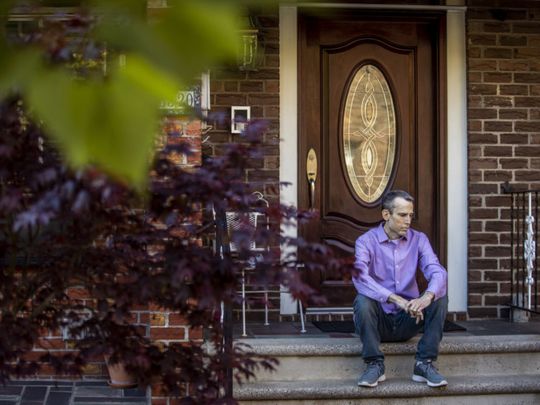
New York: It was the call that Lance Hansen, gravely ill with liver disease, had been waiting weeks for, and it came just before midnight in late April. A liver was available for him. He got up to get dressed for the three-hour drive to San Francisco for the transplant surgery.
And then he panicked.
“Within five minutes after hanging up, he started hyperventilating,” his wife, Carmen, said. “He kept saying: ‘I’m going to get COVID, and then I’m going to die. And if I die, I want my family there.’ I couldn’t believe what I was hearing.”
She promised she would wait outside the hospital, as patients’ families were barred from entering. She warned that he might not get another chance at a new liver before it was too late. She told him he could die if he didn’t go. Still, Hansen, 59, refused.
In a world seeded with anxiety, fear is gripping not just people who are ill with the coronavirus but also those in urgent need of other medical care. Even as the number of COVID cases declines in many places, patients with cancer, heart disease and strokes, among others, are delaying or forgoing critical procedures that could keep them alive. And as the virus reignites in pockets of the country, people are ignoring symptoms altogether, afraid to set foot in emergency rooms or even doctors’ offices.
Under orders from their states, many hospitals cancelled elective surgeries like hip replacements as COVID cases soared. Now most are gradually allowing the resumption of elective surgeries. But for these, as well as for more time-sensitive procedures like cardiac catheterisations, cancer surgery and blood tests or CAT scans to monitor serious chronic conditions, doctors now find themselves spending hours on the phone trying to coax terrified patients to come in.
In a review of its claim and pre-authorisation data for seven acute conditions, including heart attacks, appendicitis and aortic aneurysms, insurance company Cigna Corp. found declines ranging from 11% for acute coronary syndromes to 35% for atrial fibrillation in the rate of hospitalisation over a recent two-month period. In a study published Tuesday in The New England Journal of Medicine, Kaiser Permanente reported a drop of nearly 50% in heart attack admissions in its Northern California hospitals.
At the University of Rochester Medical Centre in Rochester, New York, emergency room visits dropped by 50%, and many of the patients who do come have waited too long to seek treatment. They “are presenting late with strokes and heart attacks,” said Dr. Michael Apostolakos, the system’s chief medical officer. “Or they’re not showing up until they can barely breathe from heart failure.”
In Newark, New Jersey, emergency medical services teams made 239 on-scene death pronouncements in April, a fourfold increase from April 2019. Fewer than half of those additional deaths could be attributed directly to COVID-19, said Dr. Shereef Elnahal, president and chief executive of Newark’s University Hospital.
Declining crucial, potentially life-saving treatment might seem irrational. Mental health experts explain that anxiety affects the part of the brain involved in thinking and planning for the future. It arises when that part, the prefrontal cortex, doesn’t have enough information to accurately predict what lies ahead, causing the brain to spin scenarios of dread.
Enter panic
“If you have anxiety and then you exacerbate that by watching the news and reading social media, that’s where you get panicked,” said Dr. Jud Brewer, a psychiatrist and behavioural neuroscientist at Brown University. “And the rational, thinking parts of the brain stop functioning well when we’re panicked.”
Panic, in turn, can lead to impulsive behaviour and dangerous decisions, Brewer and others said.
“People are saying: ‘So I’m having a heart attack. I’m going to stay home. I’m not going to die in that hospital,’” said Dr. Marlene Millen, a primary care physician at the University of California, San Diego. “I’ve actually heard that a few times.”
Most hospitals and outpatient clinics have made changes designed to keep patients and staff members safe. Many are testing patients and certain workers. In many hospitals, COVID patients are kept in separate units. Masks are usually mandated for both patients and clinicians. Cleaning protocols have been turbocharged. As a result, experts say, the risk of acquiring COVID when going into a hospital is very low.
But one of the common safety measures — banning visitors, even close family members — is a huge reason for patients’ fear and apprehension.
“The hospital was an ominous, nerve-racking and scary place for patients even before COVID,” said Dr. Lisa VanWagner, a transplant hematologist at Northwestern Medicine in Chicago. “Now you take a stressful situation like a pandemic and you tell people that they cannot have their normal support system while they’re in the hospital, and that really magnifies those fears.”
Health system administrators are redoubling their efforts to convince patients that it is safe to come into hospitals and outpatient clinics, even as testing for hospital personnel and patients remains spotty.
“Our goal is to spend almost all our marketing dollars over the next year around the safety of our institution,” said Dr. Stephen Klasko, chief executive of Jefferson Health, a 14-hospital system based in Philadelphia.
Some doctors are helping patients with chronic illnesses rethink aspects of their care.
For the past 21 years, Rob Russo, 45, has been living with a rare type of gastrointestinal cancer that has spread to his liver. For years, he made regular trips from his home in New York City to Dana-Farber in Boston. When the pandemic hit, Russo’s oncologist helped him transfer much of his care to Memorial Sloan Kettering Cancer Centre and NewYork-Presbyterian/Weill Cornell Medical Centre in New York.
At the end of April, Russo needed a procedure at Weill Cornell to unclog a stent that was keeping his biliary duct open. Before the procedure, Russo’s mind churned with scenarios: The place was teeming with the virus. What if someone with asymptomatic COVID-19 infected him, and he needed to be hospitalised? And what if that meant never seeing his wife again?
“She could drop me off, and it’s the last time we’d see each other,” he said.
Like others interviewed for this story, Russo found that once he had arrived at the hospital, he felt safe. Multiple safety precautions were taken. The procedure went well. But before the procedure, he was tested for COVID. The test came back positive. Now he’s quarantined on a separate floor in his house.
Bill Sieber, a psychologist at UCSD, said the key for fearful patients was to develop a semblance of control over their predicament.
“Control is key,” Sieber said. “If you can’t control the fact that your spouse can’t come into the recovery room, ask what you can control.”
Sieber also recommended working through episodes of panic with breathing.
“We can control our breathing in a major way,” he said. “Breathing signals the brain to calm down.”
One step he suggested was taking one extra second to prolong an exhalation.











